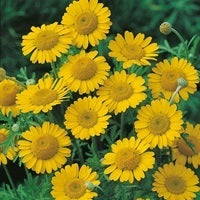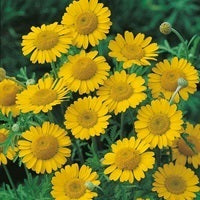Dyers Chamomile (Anthemis tinctoria)
Dyers Chamomile (Anthemis tinctoria)
Packet Size: 100 seeds
Couldn't load pickup availability
A vibrant plant with a rich history, Dyer's Chamomile (Anthemis tinctoria) has been used since medieval times to produce a warm lemony yellow dye. It's also a fantastic plant for wildlife, supporting bumblebees, solitary bees, and hoverflies, which are essential for gardens. The aromatic, silvery-green, feathery foliage is adorned with pretty yellow daisy-like flowers, which can be regularly harvested to provide sufficient for dyeing. Growing to 45-60cm in height, it flowers in summer. Though a short-lived perennial, it’s best grown as an annual.
🌱 Seasonal Growing Guide
SOW:
- Sow in spring or early autumn in moist seed trays or small pots. Lightly cover the seeds with compost or vermiculite.
GROW:
- when large enough to handle plant out or pot up autumn sowings to overwinter.
- Space at 15cm for an edging, 20-25cm for a drift.
- Like sunny & well-drained soil, not rich.
- Height 45-60cm
- Flowering Aug-Sept 1st year, earlier from 2nd year.
- Cut close to the ground in September.
📌USES
NATURAL DYE PLANT – dyeing information will be added as soon as I can - R
- Dyers Chamomile gives a warm lemony yellow colour
- The flower heads are picked as they mature and are then dried or they can be frozen without damaging their dyeing properties
WILDLIFE FRIENDLY
- Much loved by bumblebees, especially Common Carder and Red-tailed bumblebees.
- Solitary bees such as Leafcutter and Mining bees often visit for nectar.
- Attracts hoverflies, which help with pollination and also feed on aphids.
- Leave some flowers to set seed and small birds may feed on them later in the season.
- Included on the RHS Plants for Pollinators list.
HOUSHOLD
- Good cut flower
HISTORICAL
- Used as a dye plant from Medieval times.
- Medicinal use is not well researched so caution should be taken – it is said that the plant has antispasmodic, diaphoretic, emetic and vesicant properties.In simple terms ‘vesicant’ means to cause blisters, deliberately using the leaves to rub on to insect stings is not encouraged.
- Please Note: we do not promote the medicinal use of plants – guidance and information should be sought elsewhere.

Collapsible content
Sowing
- Mar
- Apr
- May
- Sep
Harvesting / Flowering
- Jul
- Aug
- Sep
- Jul
- Aug
- Sep
- Jun

